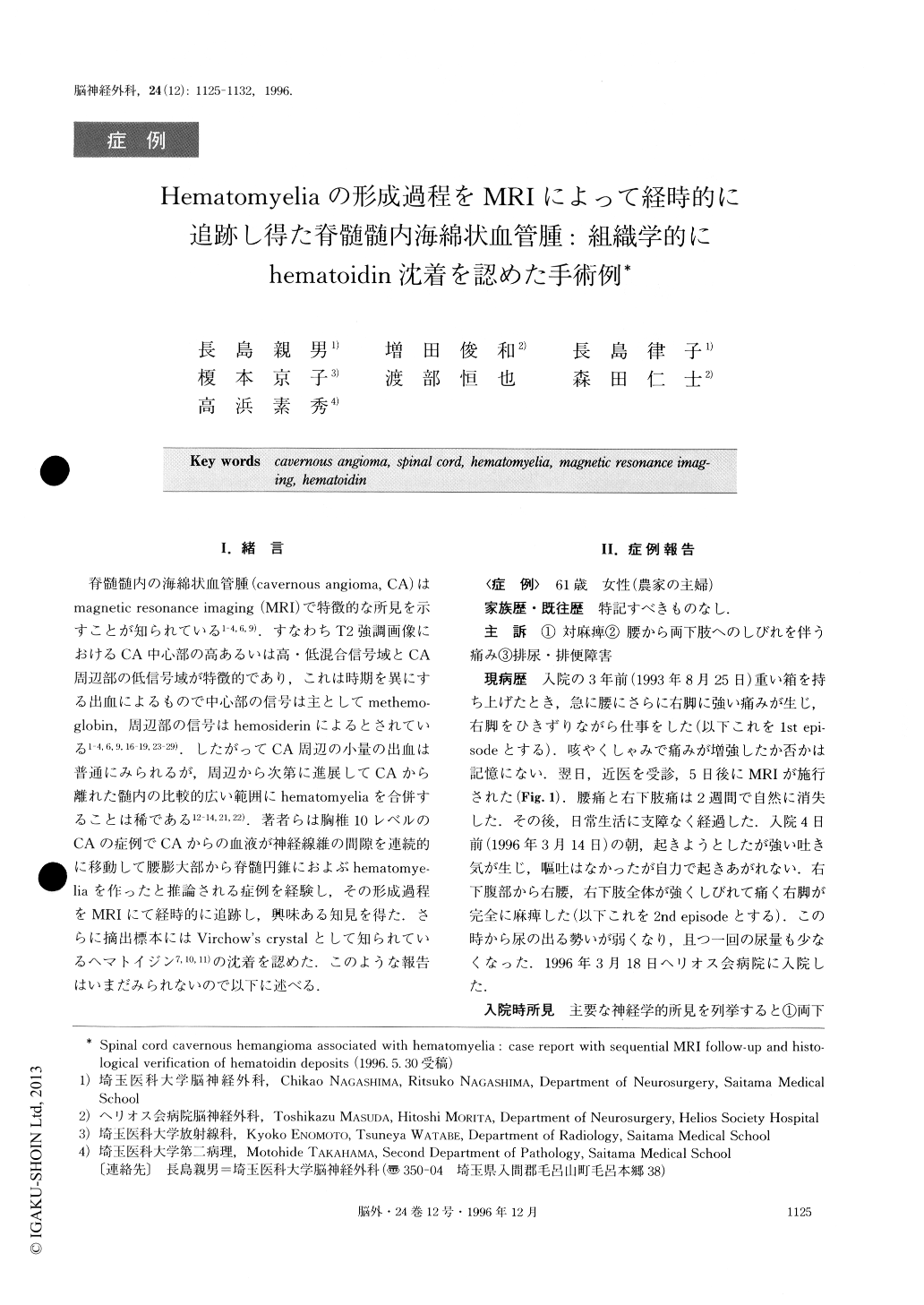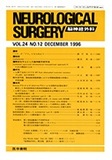Japanese
English
- 有料閲覧
- Abstract 文献概要
- 1ページ目 Look Inside
I.緒言
脊髄髄内の海綿状血管腫(cavernous angioma,CA)はmagnetic resonance imaging(MRI)で特徴的な所見を示すことが知られている1-4,6,9).すなわちT2強調画像におけるCA中心部の高あるいは高・低混合信号域とCA周辺部の低信号域が特徴的であり,これは時期を異にする出血によるもので中心部の信号は主としてmethemo—globin,周辺部の信号はhemosiderinによるとされている1-4,6,9,16-19,23-29).したがってCA周辺の小量の出血は普通にみられるが,周辺から次第に進展してCAから離れた髄内の比較的広い範囲にhematomyeliaを合併することは稀である12-14,21,22).著者らは胸椎10レベルのCAの症例でCAからの血液が神経線維の間隙を連続的に移動して腰膨大部から脊髄円錐におよぶhematomye—liaを作ったと推論される症例を経験し,その形成過程をMRIにて経時的に追跡し,興味ある知見を得た.さらに摘出標本にはVirchow’s crystalとして知られているヘマトイジン7,10,11)の沈着を認めた.このような報告はいまだみられないので以下に述べる.
A 61-year-old woman first experienced sudden lower back and right leg pain 3 years prior to surgery. At this time, MRI showed an intramedullary cavernous angio-ma at Th10-11 with central T2 high and peripheral T2 low signal intensity. However, she completely re-covered in two weeks. Four days prior to the present admission (day of the second hemorrhage), she again experienced severe lower back and right leg pain, fol-lowed by complete paralysis of the right leg. Despite vigorous medical treatment including administration of steroid, hemostatics and glycerol, her condition became aggravated with complete paraplegia and loss of sphincter control by the 4th hospital day. MRI taken two days after the second hemorrhage showed an in-crease of peritumoral T2 hypointensity and another area of T2 hypointensity in the lumbar spinal cord at L1-Th12 with cord swelling. MRI 13 days after the second hemorrhage showed that these areas of T2 hypointensity had changed to T1 and T2 hyperintensity suggesting conversion of deoxyhemoglobin to methe-moglobin. Subsequent MRI showed longitudinal punc-tuate propagation of methemoglobin from the angioma down to the lumbar enlargement and into the conus medullaris, where a 30×6mm spindle-shaped area of T1 and T2 hyperintensity indicating hematomyelia had formed. Total removal of the angioma was followed by gradual recovery and decrease in the size and signal in-tensity of the hematomyelia. Histopathological exami-nation demonstrated the typical features of cavernous angioma with deposition of hematoidin. Propagation of extravasated blood from the ruptured thoracic caver-noma to the conus medullaris, with splitting of spinal cord nerve fibers, was demonstrated by MRI.

Copyright © 1996, Igaku-Shoin Ltd. All rights reserved.


